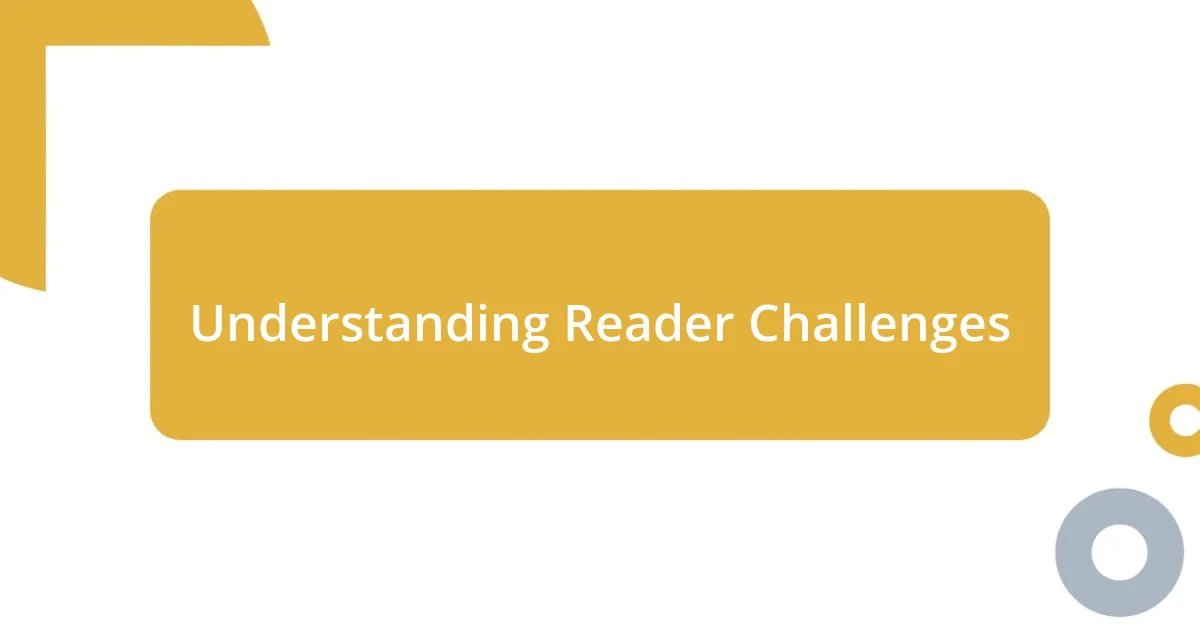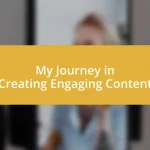Key takeaways:
- Reader challenges stem from cognitive overload, emotional states, cultural differences, and complex language, which can hinder comprehension.
- Building empathy through personal reflection and relatable language can significantly enhance reader engagement and understanding.
- Adapting content for diverse audiences by incorporating feedback and cultural sensitivity fosters inclusivity and strengthens the connection between the writer and readers.

Understanding Reader Challenges
Understanding reader challenges is a complex journey that often involves more than just recognizing barriers to comprehension. I recall a time I struggled with a dense academic article filled with jargon. It left me wondering — how many readers feel discouraged when faced with similar obstacles in their reading?
Also, it’s fascinating to consider how individual backgrounds play a huge role in how we process information. For instance, my friend, who comes from a non-English-speaking background, often finds idiomatic expressions baffling. This highlights a critical question: how many nuances do we overlook in our writing that could alienate or confuse our audience?
Furthermore, emotional responses can significantly impact a reader’s engagement. I’ve noticed when I’m anxious or stressed, I frequently re-read passages without truly grasping them. It made me realize: when we discuss reader challenges, we must also acknowledge the mental and emotional states that can hinder our ability to connect with the text.

Identifying Common Reader Issues
Identifying common reader issues often requires a nuanced understanding of both cognitive and emotional factors. I remember a time when I tried to navigate a particularly complex plot in a novel, which became overwhelming due to my eagerness to understand every detail. It dawned on me that many readers might experience similar frustrations, whether it’s from literary complexity, emotional distraction, or even unfamiliar cultural references.
Some common reader issues include:
- Jargon and Complex Language: Technical words can create barriers, making readers feel alienated.
- Cognitive Overload: Dense information can lead to fatigue and disengagement.
- Cultural References: Readers from diverse backgrounds may struggle to relate to specific examples or idiomatic expressions.
- Emotional State: Stress or anxiety can impede comprehension, leading to a cycle of re-reading without understanding.
- Distractions: In today’s digital age, interruptions can lead to loss of focus on the material.
These issues can significantly affect reading experiences, and recognizing them equips us to foster a more inclusive and engaging literary environment.

Building Empathy with Readers
Building empathy with readers is about truly understanding their individual journeys and challenges. I remember attending a book club where we discussed a novel filled with heavy themes. Some members revealed that they felt deeply connected to the characters because of personal experiences. This made me realize how crucial it is to write with sensitivity, as everyone comes with their own set of emotions and backgrounds that shape their perceptions.
When I write, I frequently consider how my own experiences influence my interpretation of text. For instance, after a particularly tough week, a quirky story might lift my spirits more than a profound one. I think this reflects a universal truth: readers often seek solace or connection in literature. Recognizing these emotional undercurrents can guide us in creating content that resonates more deeply with diverse audiences.
It’s not just the content but also the tone and approach that foster empathy. I once read a heartfelt letter from an author who shared their struggles with vulnerability. That transparency forged a connection; instantly, I felt as if I was conversing with a friend. When we express our challenges, it invites readers to do the same, cultivating a shared understanding that can bridge gaps.
| Aspect | Empathetic Approach |
|---|---|
| Personal Reflection | Shared Stories |
| Language Choice | Inclusive and Relatable |

Strategies to Engage Readers
Engaging readers starts with the power of storytelling. I vividly recall reading a novel that opened with a gripping personal anecdote from the author’s life. It immediately drew me in and made me hungry for more. When we share stories that resonate with our experiences, we invite readers to connect on a deeper level, sparking curiosity and emotional investment in the narrative.
Another effective strategy involves using relatable language. I was once at a seminar where a speaker used jargon-laden terms that felt inaccessible. The moment they switched to a more conversational tone, I felt included and engaged. By simplifying our language and using everyday expressions, we ensure that our readers feel seen and valued, regardless of their background or expertise.
It’s also essential to ask questions that provoke thought and invite readers into the dialogue. For instance, while writing about a character’s moral dilemma, I might pose, “Have you ever found yourself torn between two choices that seemed equally right or wrong?” This not only encourages readers to reflect on their experiences but also fosters a sense of community. When we relate personal challenges, it creates a shared space for readers to explore their own narratives and feelings.

Techniques for Overcoming Challenges
One technique I’ve found invaluable is breaking down challenges into manageable steps. When I faced writer’s block during a particularly demanding project, I started by setting a timer for ten minutes each day, just to write anything that came to mind. This simple habit not only eased my pressure but also helped me discover unexpected ideas hidden within my thoughts.
Another approach involves seeking feedback from trusted peers. I remember feeling overwhelmed by the criticism I received during a workshop for a short story. Initially, it stung, but after taking a moment to reflect, I realized their insights could reshape my narrative. Embracing constructive criticism often opens new perspectives while reaffirming that growth is a continual journey.
Also, I find that practicing mindfulness can significantly shift my mindset when facing obstacles. I often take a few minutes to breathe deeply and visualize my desired outcome before tackling a challenge. This small act of mindfulness not only calms my nerves but also reinforces my commitment to persevere. Have you ever noticed how a moment of quiet reflection can lead to clarity? It truly transforms my approach to any hurdle I encounter.

Measuring Reader Engagement Success
Measuring reader engagement success requires more than just tracking numbers; it’s about understanding the emotional connections we foster through our content. I remember when I published a piece that unexpectedly sparked a vibrant discussion in the comment section. The sheer volume of responses revealed how deeply readers were impacted, reminding me that engagement isn’t solely about click-through rates—it’s about creating a space for authentic dialogue.
One way I measure engagement is by analyzing feedback and comments. I once received a note from a reader who shared how a particular story resonated with their personal life. That moment illuminated the true purpose of my writing: forging connections. It’s fascinating how a simple, heartfelt message can provide more insight into reader engagement than any statistic could.
Additionally, I find it helpful to look for trends in how readers interact with my work across platforms. For example, I’ve noticed that posts with thought-provoking questions generate more shares and discussions than standard updates. Have you ever considered how deeply a well-placed question can draw readers in? I believe that active engagement signifies not only interest but also resonates on a level that encourages ongoing exploration and dialogue.

Adapting Approaches for Diverse Audiences
Adapting my approach for diverse audiences is something I take seriously, especially when crafting content that needs to resonate broadly. I recall an experience where I wrote an article for both seasoned professionals and newcomers in my field. I had to balance technical jargon with simplified explanations. It was essential to ensure that while skilled readers found depth, those new to the subject felt welcomed and included. How do you strike that delicate balance? I’ve found that clear definitions and relatable examples can bridge that gap effectively.
Additionally, I often think about the cultural backgrounds of my audience. During a webinar I led, I included references that resonated with the different experiences of the participants. It was striking to see how much more engaged they became when I acknowledged their unique perspectives. I believe that when we tailor our content to reflect these diverse narratives, it not only boosts participation but fosters a sense of community. Have you experienced the power of cultural sensitivity in your writing? It can genuinely transform the dialogue.
Finally, it’s crucial to embrace feedback that highlights audience diversity. I remember a time when a reader pointed out that my usual examples didn’t reflect their experiences. Initially, it stung, but it sparked an important realization: each audience member carries their own story, and my goal is to include as many of these narratives as possible. So, I now actively seek out input from a wider array of voices, recognizing that this fosters richer content. How can we truly grow if we don’t listen to those we aim to reach? Embracing different viewpoints not only enhances our writing but also enriches our personal connection with each reader.












